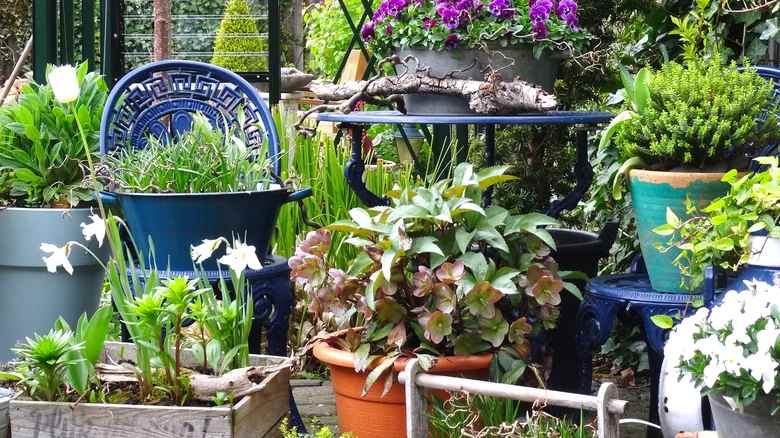How To Create A Flourishing Vegetable Garden In A Small Space

Collected Image
Sure, we plant addicts would love to have a flourishing garden that fills the grounds of a multi-acre estate and makes the neighbors weep with joy and a little bit of jealousy. For many of us, of course, that dream must be squeezed into a rather tight reality. Sometimes a 4-foot square patch of grass or a corner of the patio is all we can devote to our beloved garden. At first sight, it seems like we'll barely be able to grow anything, but with a little creativity and smart planning, we can create a bountiful harvest in even the smallest spaces. Savvy gardeners have figured out how to grow their precious produce and beautiful blooms just about anywhere. Once you've identified the location of your modest garden, take a deep breath and worry not. We're here to share with you some inspired vegetable garden ideas along with key planting techniques that will help you get the most out of whatever space you have.
Utilize raised beds and containers
Got concrete? If you're standing on your back porch bemoaning your lack of an actual grass and dirt yard, you'll want to consider raised garden beds and containers right off the bat. They're conveniently mobile and hold enough soil to grow vegetables no matter what kind of surface they're standing on. Both options can be squeezed into tight spaces, and with raised beds, you can easily build one to fit a customized layout as you attempt to use every inch of a petite patio. You may even discover that you have a few vegetables growing in containers that will be perfectly happy inside your house on a windowsill. And don't forget about the front porch!
Besides helping you get around space constraints, containers and raised beds allow fewer weeds in the soil and less water runoff. You're also less likely to find yourself dealing with pests since they're elevated off the ground. From a physical standpoint, the height of a raised bed can be adjusted to accommodate less bending and kneeling, and they can be situated away from walls to let you comfortably move around on all sides for less reaching.
Get vertical
When you're short on floor space, it's time to stop focusing on the ground and look up instead. There are a number of different ways to get vertical in the garden. Trellises and fences let you train vining vegetables like cucumbers and squash up and away from the ground. Cages do something similar for tomatoes. Hanging baskets can be placed all over the place; in this way, you'll spread your garden out to find as many usable nooks and crannies as possible. Just make sure that everything is within reach of the garden hose, so you don't end up schlepping heavy watering cans.
Another thing to consider is installing shelves along an exterior wall. You can keep it simple by lining containers across them, or if you're a DIY enthusiast, have fun designing wall-mounted garden beds. Keep in mind the weight of the soil and the water, as well as the fact that everything will be getting wet on a regular basis. And don't forget to accommodate for sufficient drainage.
Utilize raised beds and containers
Got concrete? If you're standing on your back porch bemoaning your lack of an actual grass and dirt yard, you'll want to consider raised garden beds and containers right off the bat. They're conveniently mobile and hold enough soil to grow vegetables no matter what kind of surface they're standing on. Both options can be squeezed into tight spaces, and with raised beds, you can easily build one to fit a customized layout as you attempt to use every inch of a petite patio. You may even discover that you have a few vegetables growing in containers that will be perfectly happy inside your house on a windowsill. And don't forget about the front porch!
Besides helping you get around space constraints, containers and raised beds allow fewer weeds in the soil and less water runoff. You're also less likely to find yourself dealing with pests since they're elevated off the ground. From a physical standpoint, the height of a raised bed can be adjusted to accommodate less bending and kneeling, and they can be situated away from walls to let you comfortably move around on all sides for less reaching.
Get vertical
When you're short on floor space, it's time to stop focusing on the ground and look up instead. There are a number of different ways to get vertical in the garden. Trellises and fences let you train vining vegetables like cucumbers and squash up and away from the ground. Cages do something similar for tomatoes. Hanging baskets can be placed all over the place; in this way, you'll spread your garden out to find as many usable nooks and crannies as possible. Just make sure that everything is within reach of the garden hose, so you don't end up schlepping heavy watering cans.
Another thing to consider is installing shelves along an exterior wall. You can keep it simple by lining containers across them, or if you're a DIY enthusiast, have fun designing wall-mounted garden beds. Keep in mind the weight of the soil and the water, as well as the fact that everything will be getting wet on a regular basis. And don't forget to accommodate for sufficient drainage.
Source: https://www.housedigest.com
Previous Story
- Nasa space probes document big impacts on Mars
- First European astronaut to walk on Moon by...
- Five planets line up in rare planetary conjunction
- Spacecraft Captures Remarkable Image of James Webb Space...
- NSO: Inouye Telescope project passes final construction review
- Why will it take six months to see...
- Tech notes from the 2021 FM Solutions and...
- Rocket Lab acquires Planetary Systems Corporation in cash...